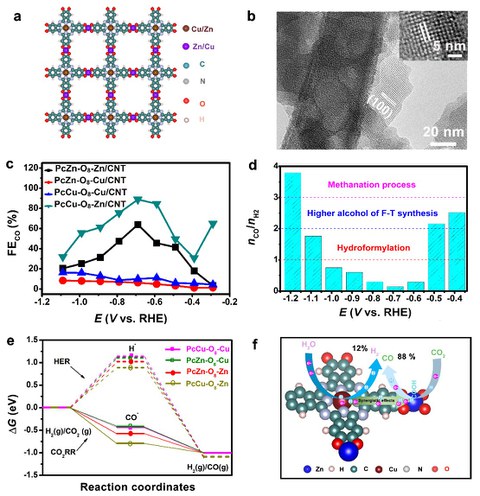Mar 18, 2020
Synergistic electroreduction of carbon dioxide to carbon monoxide on bimetallic layered conjugated metal-organic frameworks
Electrocatalytic carbon dioxide reduction reaction (CO2RR), coupled to renewable energies, offers sustainable opportunities to produce value-added chemicals/fuels. Specifically, electrochemical reduction of CO2 to C1 products (formic acid and CO) is of high relevance for the chemical industry, which can also yield a mixture of CO as carbon-reduced product and H2 as byproduct, which is the components of syngas. However, CO2-to-CO conversion, typically suffers from high kinetic barriers and low selectivity due to the high thermodynamic/kinetic stability of CO2 and the competing hydrogen evolution reaction (HER) in aqueous media, respectively. Despite significant efforts to exploring effective catalysts, the current single site catalysts still fail to meet the requirement of electrochemical syngas synthesis with tunable H2/CO ratio at low overpotential. Therefore, developing highly active and selective electrocatalysts to adjust the competitive reactivity between the CO2RR and HER at room temperature, is imperative.
In order to address these challenges, researchers from Technical University of Dresden (Chair for Molecular Functional Materials) and collaborators have developed a layer-stacked, bimetallic two-dimensional conjugated metal-organic framework (2D c-MOF) with copper-phthalocyanine as ligand (CuN4) and zinc-bis(dihydroxy) complex (ZnO4) as linkage (PcCu-O8-Zn). The PcCu-O8-Zn exhibits high CO selectivity of 88%, turnover frequency of 0.39 s1 and long-term durability (> 10 h), surpassing thus by far reported MOF-based electrocatalysts. The molar H2/CO ratio (1:7 to 4:1) can be tuned by varying metal centers and applied potential, making 2D c-MOFs highly relevant for syngas industry applications. The contrast experiments combined with operando spectroelectrochemistry and theoretical calculation unveil a synergistic catalytic mechanism; ZnO4 complexes act as CO2RR catalytic sites while CuN4 centers promote the protonation of adsorbed CO2 during CO2RR. This work offers a strategy on developing bimetallic MOF electrocatalysts for synergistically catalyzing CO2RR toward syngas synthesis.
Reference: Haixia Zhong, Mahdi Ghorbani-Asl, Khoa Hoang Ly, Jichao Zhang, Jin Ge, Mingchao Wang, Zhongquan Liao, Denys Makarov, Ehrenfried Zschech, Eike Brunner, Inez M. Weidinger, Jian Zhang, Arkady V. Krasheninnikov, Stefan Kaskel, Renhao Dong and Xinliang Feng. Synergistic Electroreduction of Carbon Dioxide to Carbon Monoxide on Bimetallic Layered Conjugated Metal-Organic Frameworks. Nat. commun. 2020, 11, 1409.
This work is financially supported by EU Graphene Flagship (GrapheneCore2 785219) and Coordination Networks: Building Blocks for Functional Systems (SPP 1928, COORNET), as well as the German Science Council and Center of Advancing Electronics Dresden (cfaed). This project also has received funding from the European Research Council (ERC) under the European Union’s Horizon 2020 research and innovation programme (FC2DMOF, grant agreement No. 852909). H.X.Z. gratefully acknowledges funding from the Alexander von Humboldt Foundation. I.M.W. acknowledges the Cluster of Excellence UniSysCat. We acknowledge Dresden Center for Nanoanalysis (DCN) at TUD and Dr. Petr Formanek (Leibniz Institute for Polymer Research, IPF, Dresden) for the use of facilities. We also thank Mr. Zhiyong Wang and Dr. Chongqing Yang for helpful discussions. We thank the beamline scientists at BL14W1 and BL15U1 of the Shanghai Synchrotron Radiation Facility for the XAFS measurements. We thank Mr. Chenbao Lu and Prof. Xiaodong Zhuang for the in-situ XAS electrochemical cell setup, as well as Wei Li for the ex-situ Raman testing. We thank Mr. Zhe Zhang for helping prepare the Au/CP current collector. The computational support from the HZDR computing cluster is gratefully appreciated.

